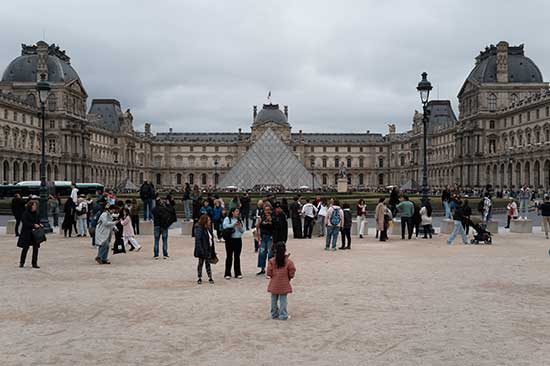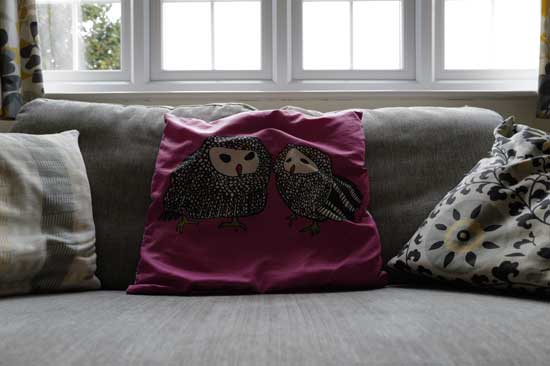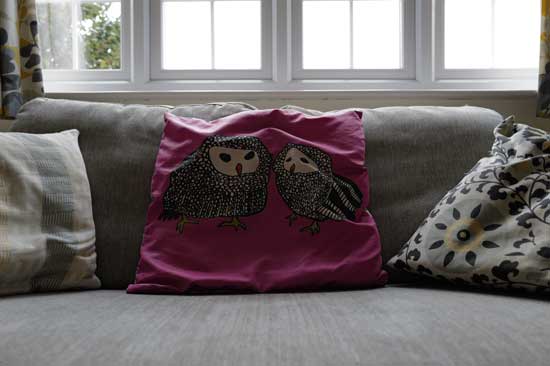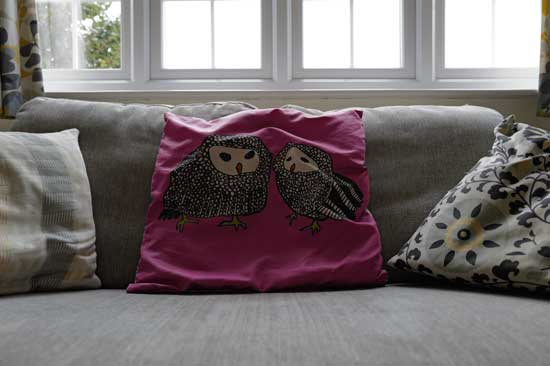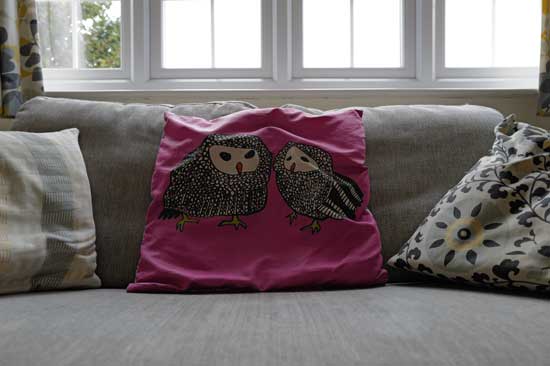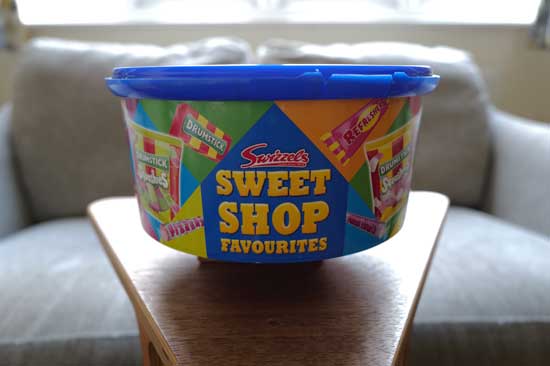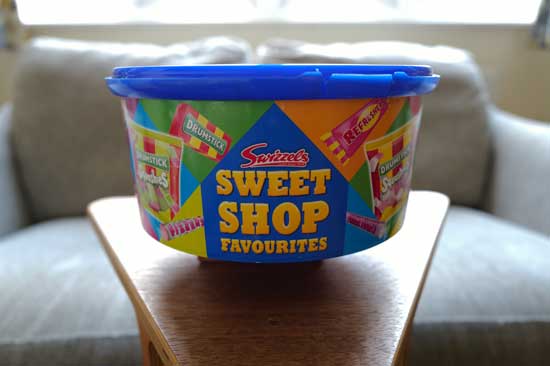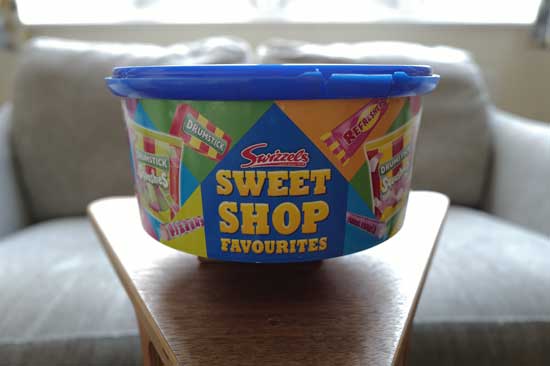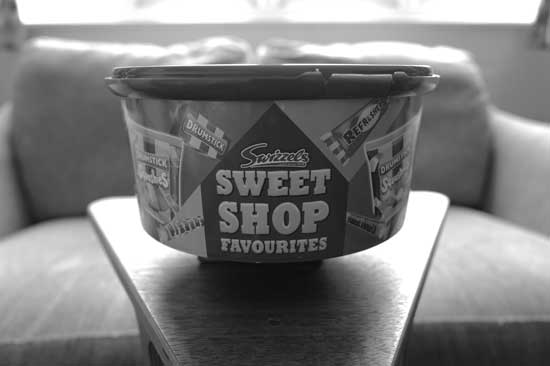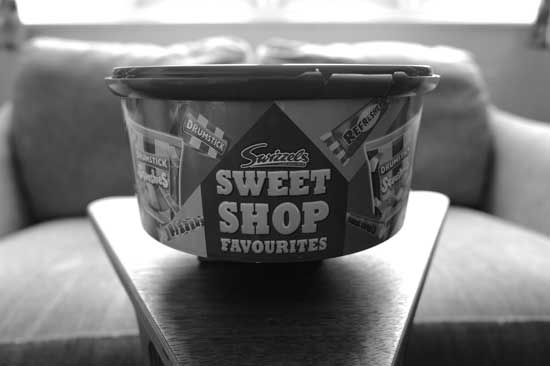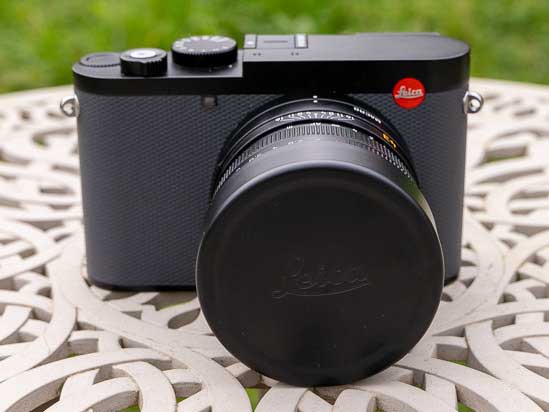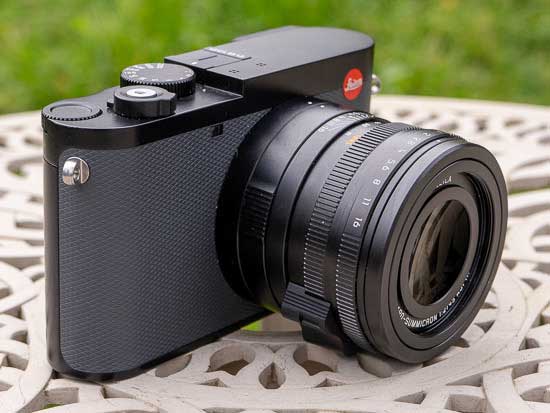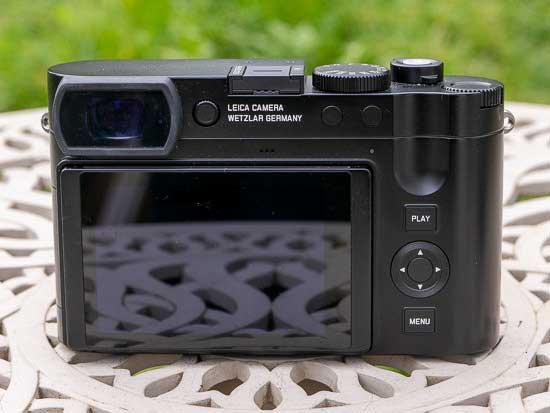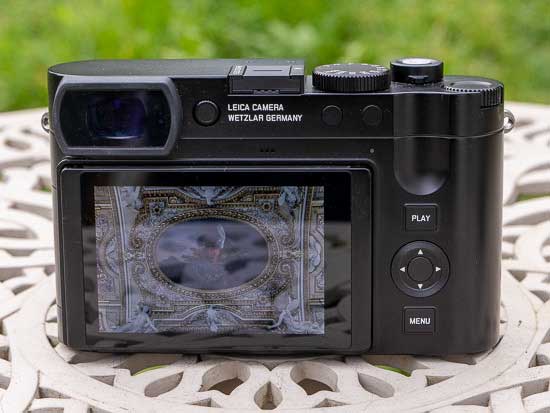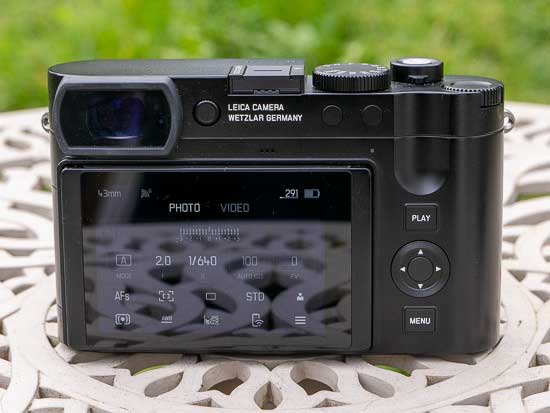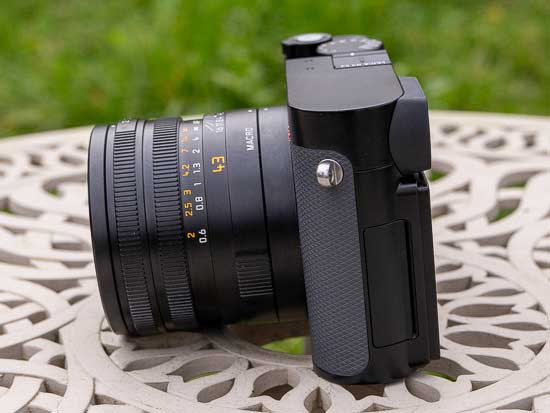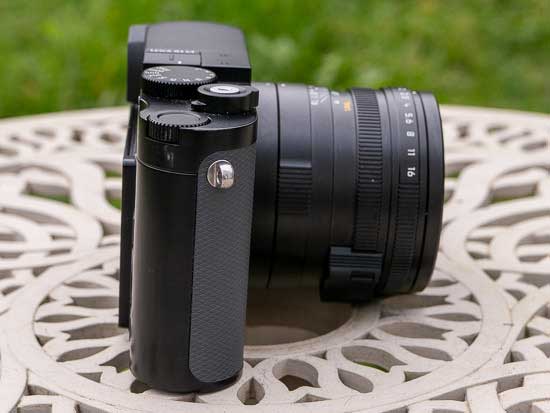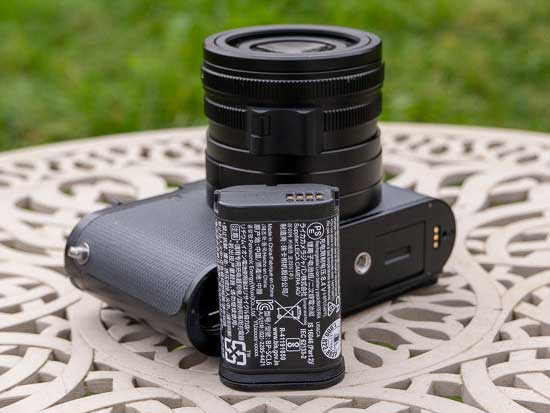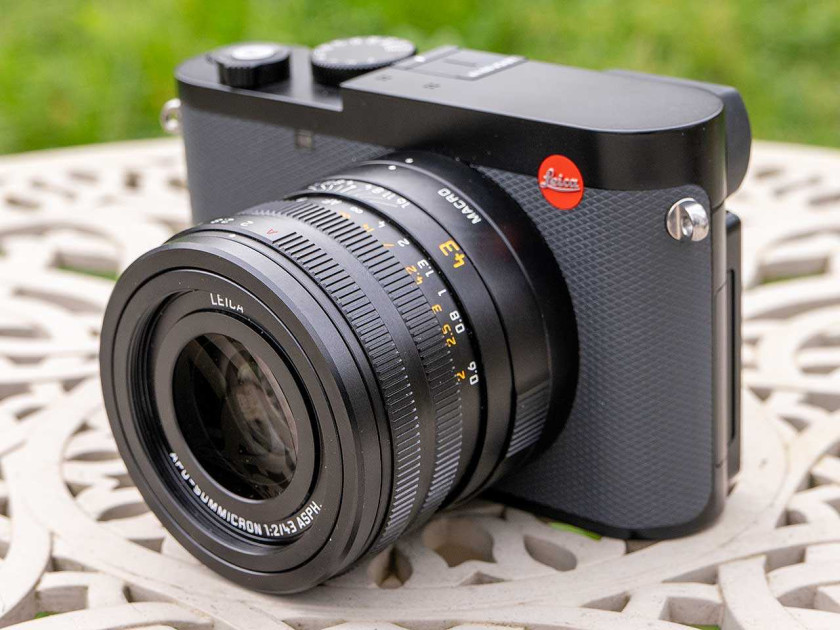
Introduction
The Leica Q3 43 is a premium fixed lens compact camera which pairs a 60 megapixel 35mm full-frame CMOS sensor with an image-stabilized Leica Summilux 43mm f/2 prime lens.
Optically, this brand new lens is comprised of 11 lenses in 8 groups including 7 aspherical lens elements and it has a Macro setting that enables it to focus as close as 26.5cms / 10.4″.
This camera uses the same BSI (BackSide Illuminated) CMOS sensor as the M11 rangefinder, which utilises a specially developed dual-layer UV/IR cut-off filter.
Key features of the Q3 43 include an expanded sensitivity range of ISO 50-100,000, the latest-generation Maestro IV image processor, 8K/30p, 4K/60p and 1080/120p video recording, a hybrid AF system with an intelligent subject recognition system, and continuous shooting up to 15fps.
This new model for 2024 also offers 350 shot battery life, USB-C connectivity, a 5.76m-dot OLED EVF and a tilting 1.84m-dot touchscreen LCD screen.
The recommended retail price of the Leica Q3 43 is £5900 / $6895 and it is available in grey/black. It is designed and made in Germany.
Ease of Use
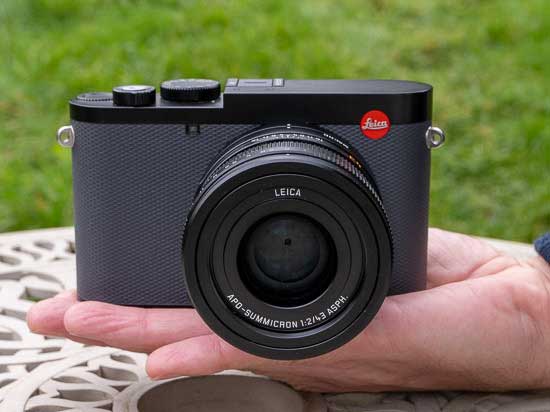 |
There is only really one key difference between the new Leica Q3 43 and the original Q3 from mid-2023, and that’s the lens.
Whereas the Q3 has a wide-angle 28mm f/1.7 lens, as its name suggests the Q3 43 has an unusual 43mm optic that provides a more normal view of the world.
This is because on a 35mm full-frame sensor, 43mm is the length of the diagonal measurement, so the 43mm focal length perfectly matches the sensor and thereby more closely matches human vision than either a 50mm or 35mm lens.
Choosing between the original Q3 and the new Q3 43 is therefore a simple choice between the angle of view – 28mm “wide” versus 43mm “normal” – as in almost every other regard the two cameras are identical.
Side by side, the Q3 43 has a mid-grey leatherette coating on the front of its body, rather than the black leatherette of the original – I prefer the more stealthy approach of the Q3.
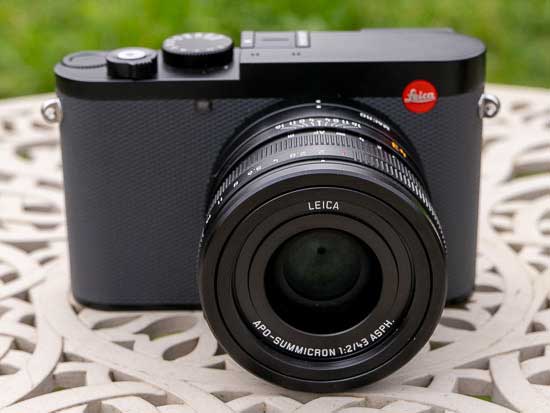 |
The other visual differences to help tell them apart are the “43” moniker that’s engraved on the lens barrel instead of “28” on the Q3 and the “Leica Q3 43” name that’s engraved on the hotshoe rather than “Leica Q3” on the original.
Despite featuring a longer lens, the two cameras are even virtually identical in size and weight – 130 x 80.3 x 97.6mm and 688g for the Q3 43 versus 130 x 80,3 x 92,6mm and 658g for the Q3 – so there’s no penalty here for choosing the Q3 43 other than the longer, heavier lens means that it tilts forwards slightly on a level surface (which is more annoying for taking product shots of the camera rather than actually using it).
The new 43mm lens has a slightly slower maximum aperture than the Q3’s 28mm optic – f/2 versus f/1.7 – but in the real world this has a negligible effect, with the longer focal length helping to compensate in terms of bokeh effects.
There’s also a difference in the Macro modes of each camera, with the Q3 43 offering a minimum focusing distance of 26.5cms / 10.4″ versus 17cms / 6.7″ on the original, but again the longer focal length helps to offset this.
Otherwise the regular minimum focusing distance is 60cm versus 30cm on the Q3, while the manually selectable aperture range extends from f/2 up to f/16 with an automatic setting provided too.
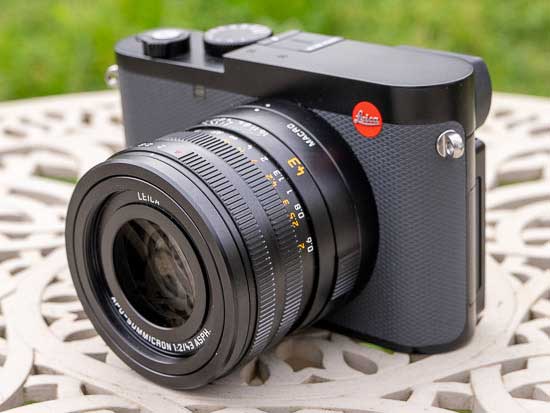 |
The change of focal length also has a direct knock-on effect on the crop modes that allow it to simulate additional focal lengths, with the Q3 43 providing 60, 75, 90 120 and 150mm equivalent crops of its sensor at 31, 21, 14, 8, and 5 megapixels respectively.
These digital crops are only applied to the JPEG files, with a full-size 60 megapixel DNG Raw file also recorded at the same time.
As the camera is cropping into the full-size image, rather than interpolating up a la most digital zooms, there’s no degradation of the image quality, just a reduction in the megapixel count.
You could of course apply similar crops yourself during post-processing, but providing them in-camera has the main added benefit of making composition much easier and more intuitive whilst also saving on memory card space.
The 60mm, 75mm and 90mm crop modes proved to be genuinely useful, effectively giving you a 43-90mm focal range that’s easy to use whilst still offering just enough resolution.
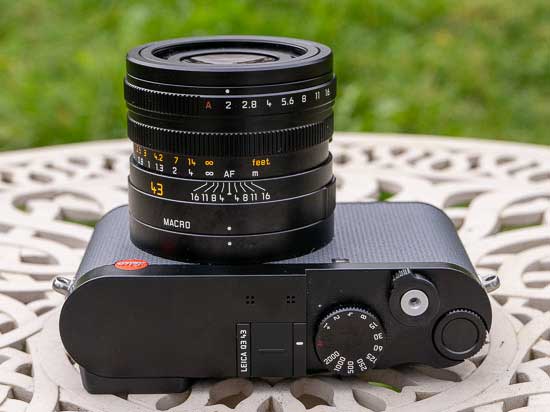 |
The 120mm and 150mm modes are harder to use due to the tiny are of the frame that’s made available for composition – the camera really needs to provide higher magnification when using these modes – and also the sub-10 megapixel resolution images that are recorded.
Thankfully, and as you’d perhaps expect from Leica, the newly designed APO-Summicron 43mm f/2 ASPH lens on the Q3 43 is truly excellent. Comprised of 11 lenses in 8 groups including 7 aspherical lens elements, it delivers pin-sharp images with very little chromatic aberrations or distortion throughout the aperture range, even wide-open at f/2.
Leica has additionally provided a screw-on/screw off lens hood, should you wish to use it as an additional aid to preventing lens flare, or avoid unwanted artifacts in brighter conditions. There’s also a thread on the front for traditional 49mm glass filters.
The Leica Q3 43 has exactly the same 60 megapixel full-frame BSI (BackSide-Illuminated) CMOS sensor that was initially developed especially for the flagship M11 rangefinder camera, which offers a 21% increase on the resolution offered by 2019’s 47.3 megapixel Q2 model.
In conjunction with the Maestro IV image processor, this allows the Q3 43 to output 14-bit raw files with a claimed dynamic range of up to 14 stops, provide an extensive ISO range of 50-100,000, and shoot 60 megapixel images at 4fps with continuous AF/AE.
 |
It also has a special IR + UV cut filter in front of the sensor which corrects even the most oblique rays of incident light and a colour filter array that offers more natural colour reproduction than the Q2.
Whilst 60 megapixels will undoubtedly be a big draw for potential owners of this camera, Leica have also sensibly provided two smaller 36 and 18 megapixel modes which help avoid some of the processing and storage challenges of the the 60 megapixel mode while also boosting the burst shooting buffer times.
So the Q3 43 can be set to record 60, 36 or 18 megapixels DNG Raw images with 14-bit color and 14-stop dynamic range using the full sensor area, something that Leica are calling “Triple Resolution Technology”.
There is no built-in flash provided on the Leica Q3 43, although there is a provided hotshoe for the addition of flash, should that be required.
As you’d probably expect of a Leica camera, manual focusing on the Q3 43 is a veritable joy, although the means of switching between AF and MF is quite subtle and initially well hidden.
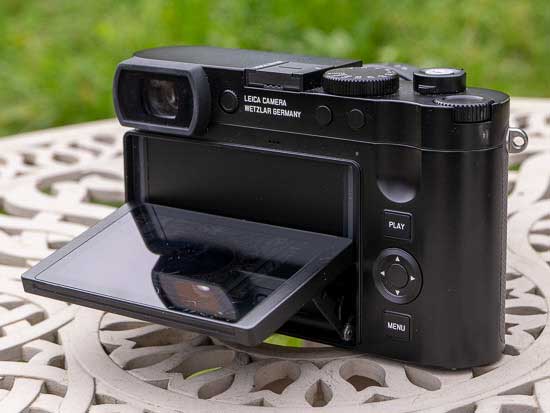 |
Switching to manual focus occurs via a fingernail press of the so tiny you’ll miss it lever on the lens itself, that in turn allows the lens ring to move (it’s ‘stuck’ in place in auto mode) and manual distance markings on said barrel to be selected, whereby the camera provides the user with an enlarged portion of the subject on-screen, allowing focus to be more critically determined.
Auto-focusing on this new Q-series camera incorporates a hybrid AF system that includes phase detection as well as contrast detection pixels, providing higher speed (5x faster than the Q2) and greater precision when focusing and tracking objects.
Interestingly, it additionally employs Panasonic’s depth from defocus system to build up a depth map of the scene to further enhance the AF.
The Q3 43 also benefits greatly from the addition of intelligent subject recognition.
It’s a pretty simple system by modern standards that only recognises the eyes, faces and bodies of people plus animals, with two rather confusing options buried at the bottom of the AF Mode menu – the first option is Eye/face/Body Detection and the second is Eye/Face/Body + Animal Detection (why isn’t animal detection separate?) – but at least it works well enough in practice.
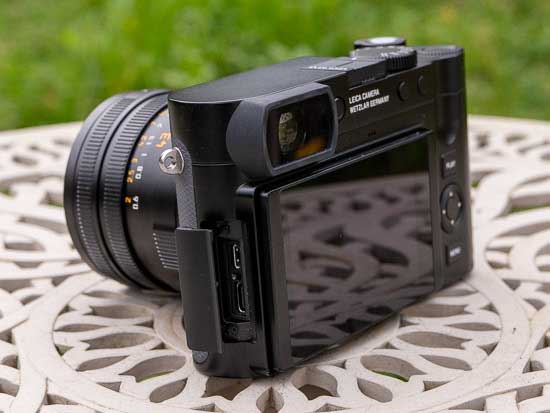 |
Leica camera have never been particularly renowned for their blistering continuous shooting rates, and the Q3 43 is certainly no exception to that rule.
While on paper it offers up to 15fps bursts, the reality is that the focus and exposure are locked at the first frame until you drop down to a rather more pedestrian 4fps. The buffer is at least 63 shots in RAW, though, so you can at least shoot for a long time at 4fps before that rate slows down.
Some photographers may also argue that 4fps is more than fast enough for a street camera with a standard focal length lens, especially as the excellent autofocus system can be employed at the same time.
The Q3 43 has both a mechanical shutter that provides speeds between 120sec to 1/2000sec and an electronic shutter that runs from 1sec to 1/16000sec, with a Hybrid option also available that automatically switches between them. Flash synchronization is up to 1/200sec.
This isn’t just a camera for stills, as Leica have included 8K video recording for the first time ever on any of their models. DCI 8K recording is supported at up to 30p with 4:2:0 10-bit color when recording internally or at 8-bit when recording externally via the micro-HDMI port.
 |
If you only need 4K recording, that’s provided at up to 60p with 4:2:2 10-bit color internally or externally, while Full HD runs up to 120p for slow motion playback.
Other key video features include ProRes recording at 1080/60p, Leica’s L-log profile, and LUT compatibility. The Q3 43 doesn’t have a microphone socket, though, instead relying on its USB-C port to allow an audio input.
This port can also be used to charge the camera via a powerbank, useful for extending the battery life when out and about. Talking of which, the Q3 43 uses a battery, the BP-SCL6, which has a CIPA-rated lifespan of 350 shots per charge. The Q3 43 is also still compatible with the BP-SCL4 battery that was used in the Q2.
The electronic viewfinder that sits in the corner of the camera has also received a significant upgrade, with the resolution being bumped up from 3.68 megapixels on the Q2 to 5.76 on the Q3 43. It has a 0.79x magnification and either a battery-conserving 60fps or a smooth 120fps refresh rate for more realistic motion rendering.
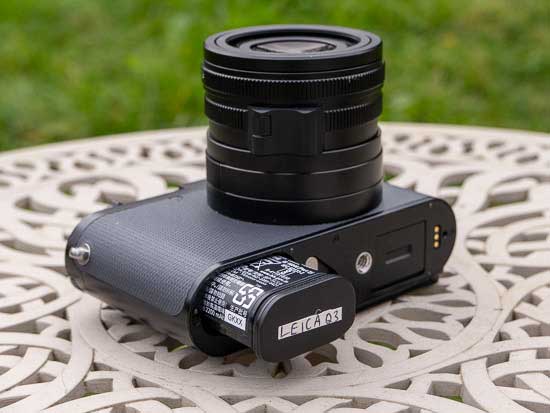 |
The tilting 3-inch, 1.84M dot LCD touchscreen can be moved both upwards and downwards to suit working from a variety of shooting positions, rather than fixed in place as on the previous Q models, which makes waist-level and overhead shooting much easier.
The screen does rather spoil the aesthetics of the Q3 43, however, as it juts out slightly from the rear of the camera, interrupting the smooth lines. Still, this is first and foremost a photographic tool, rather than an expensive ornament, so we can overlook this slight faux pas on Leica’s part.
It has also necessitated a restructuring of the controls on the rear of the camera compared to the Q2. Instead of the vertical row of three buttons to the left of the LCD screen, the Play and Menu buttons have been moved to above and below the D-pad respectively, with the customisable Function button moving alongside the Photo/Video button. The shutter button is threaded to accept a mechanical cable release.
The new Q3 43 supports the HG-DC1 Wireless Charging Handgrip, an optional accessory that when fitted facilitates wireless battery charging via Qi-compatible charging mats, such as the Drop XL Wireless Charger that Native Union has made especially for Leica.
Image Quality
All of the sample images in this review were taken using the 60 megapixel Large setting, which produces an average image size of around 30Mb for JPEGs and 85Mb for RAW files.
The Leica Q3 43 recorded still images of excellent quality during the review period.
This camera produces noise-free JPEG images at ISO 50 up to ISO 3200, with some noise appearing at ISO 6400. The faster settings of ISO 12500 through to 25000 are still usable, although we’d suggest avoiding both ISO 50000 and 100000 if at all possible. The corresponding Raw files have much less obvious colour artifacts but are noticeably less sharp than their JPEG equivalents.
The night photograph was very good, with the maximum shutter speed of 60 minutes allowing you to capture enough light in every situation, and the Film Styles, although limited in number and customisability, allow you to quickly change the look of JPEG files.
Noise
ISO sensitivity can be set between ISO 64 and ISO 100,000 in full-stop increments. Here are some 100% crops which show the noise levels for each ISO setting, with JPEG on the left and RAW on the right.
Focal Range
The Leica Q3 43’s lens provides a focal length of 43mm in 35mm terms, as demonstrated below.
Macro
The Leica Q3 43 offers a Macro setting that allows you to focus on a subject that is 26.5cms / 10.4″ away from the camera.
Night
The Leica Q3 43’s maximum shutter speed is 60 seconds in the Manual mode, which is great news if you’re seriously interested in night photography.
Intelligent Dynamic Range (iDR)
The Intelligent Dynamic Range function allows an optimization of the darker areas in a JPEG image, with object details become much clearer. There are three different available strengths, Low, Standard and High, plus Auto and Off settings.
Off
Low
Standard
High
Auto
Film Styles
Leica’s Film Styles are preset combinations of different sharpness, contrast and saturation settings, for JPEGs only. The Leica M11’s five available Film Styles are shown below in the following series, which demonstrates the differences between them. You can also tweak the preset styles so that you can create your own particular look, although you can’t create brand new ones.
Standard
Vivid
Natural
Monochrome
Monochrome High Contrast
Sample Images
This is a selection of sample images from the Leica Q3 43 camera, which were all taken using the 60 megapixel Large JPEG setting. The thumbnails below link to the full-sized versions, which have not been altered in any way.
Sample RAW Images
The Leica Q3 43 enables users to capture RAW and JPEG format files. We’ve provided some Leica RAW (DNG) samples for you to download (thumbnail images shown below are not 100% representative).
Sample Movies & Video
This is a sample 8K movie at the quality setting of 8192 x 4320 pixels at 30 frames per second.
This is a sample 4K movie at the quality setting of 3840 x 2160 pixels at 60 frames per second.
This is a sample 4K movie at the quality setting of 3840 x 2160 pixels at 30 frames per second.
Product Images
Conclusion
The new Q3 43 is a surprising, yet very welcome, addition to Leica’s full-frame camera range, essentially replacing the excellent 28mm wide-angle optic of the original Q3 model with an equally excellent 43mm lens that provides a more normal, human view of the world.
In all other respects the two cameras are identical, so choosing between them is simply a case of deciding which angle of view you prefer – if only life were that simple!
It’s perhaps important to bear in mind that the Q3 does offer 35mm and 50m crop modes at 39 and 18.9 megapixels respectively, so it provides two focal lengths that are either side of the Q3 43 with enough resolution for most uses. Whereas the Q3 43 obviously does not provide a focal length that’s wider than 43mm, so it’s more limiting in this respect.
Conversely, it’s progressively harder to actually use the Q3 as you move through its crop modes, with the 75mm and 90mm modes in particular being harder to use due to the tiny area of the frame that’s made available for composition. Still, you could make a good case for choosing the original Q3 and utilising the 35mm and 50mm crop modes in preference to the Q3 43’s starting focal length.
If you know that the majority of your shooting is done at a more “normal” focal length, though, the Q3 43 is undoubtedly the one to choose, especially if you prefer to do all of your cropping on a computer rather than in-camera.
The new Q3 43 is otherwise identical to 2023’s Q3 model in every regard except for the lens and grey finish, so it sadly doesn’t inherit all of the menu improvements that were made in the SL3 from earlier this year, including the new family of clearer “Leicons” that were intended to be clearer and more cohesive than the previous icon set.
This is a shame, especially as Leica signalled that the new UI would be rolled out on future cameras, but perhaps not entirely unexpected – maybe both the Q3 and Q3 43 will benefit from a future firmware update.
One other point of shame is the price, which at £5900 / $6895 is both significantly higher than the Q3’s launch price (£5300 / $5995) and high enough to put most users off. Again, as with the Q3, the best advice that we can give is maybe to rent one and try it out for yourself, or even test both the Q3 and Q3 43 at the same time to see which focal length you prefer!
| Ratings (out of 5) | |
|---|---|
| Design | 4.5 |
| Features | 4.5 |
| Ease-of-use | 4 |
| Image quality | 4.5 |
| Value for money | 3 |
Main Rivals
Listed below are some of the rivals of the Leica Q3 43.
The X100VI is the sixth generation of Fujfilm’s classic 35mm fixed lens premium compact camera series. It now has a 40 megapixel sensor, 6K video recording, in-body image stabilisation (IBIS) and brand new Reala Ace film simulation. Read our in-depth Fujifilm X100VI review now, complete with full-size sample images and videos…

The D-Lux 8 is that rarest of things – a brand new premium compact camera – in a market dominated by mirrorless and smartphones. Read our in-depth Leica DLux 8 review, complete with full-size sample photos and videos, to find out if it can successfully bridge the gap between those two extremes…

The Leica Q2 Monochrom is a 35mm full-frame compact camera with a 28mm fixed focal length lens that exclusively only shoots in black and white. With a price tag of £5000 / $6000, is this a niche product that no one will buy, or somebody’s idea of a dream camera? Find out now by reading our in-depth Leica Q2 Monochrom review, complete with full-size sample photos and videos…

The Leica Q2 is an exciting full-frame mirrorless compact camera with a 28mm fixed lens. The Q2 features a a new 47.3 megapixel sensor, 4K video mode recording at 30/24fps, high-resolution OLED viewfinder, dust and water resistance, and focusing speed of 0.15 seconds. Is this the ultimate compact camera? Find out now by reading our in-depth Leica Q2 review, complete with full-size sample photos and videos…

The Leica Q3 is a compact camera like no other, with a 60 megapixel full-frame sensor, 8K/30p video recording, hybrid AF system and a 28mm f/1.7 fixed lens all housed in a traditional body. Is this the ultimate tool for street and landscape photography? Find out now by reading our in-depth Leica Q3 review, complete with full-size sample photos and videos…

The Leica SL3 is a brand new digital camera with a 60 megapixel sensor, 8K/30p video recording and a hybrid AF system. Does this premium take on a 35mm full-frame interchangeable lens camera deliver premium results? Find out now by reading our in-depth Leica SL3 review, complete with full-size sample photos and videos…

After almost three years since it was first unveiled, the Zeiss ZX1 full-frame mirrorless camera is finally available to buy. With a 37.4 megapixel sensor, 4K video, 35mm f/2 prime lens, 4.3-inch touchscreen, built-in Adobe Lightroom and 512Gb SSD internal memory, is the unconventional ZX1 still worth a look in 2021? Find out now by reading our in-depth review of the Zeiss ZX1 mirrorless camera, complete with full-size sample photos, test shots, videos and more…
Review Roundup
Reviews of the Leica Q3 43 from around the web.
The Leica Q3 43 is a variant of the company’s full-frame prime lens compact, with a 43mm F2 lens mounted in front of a 60MP BSI CMOS sensor. In almost every other respect, it’s a match for the original, 28mm Q3. The longer lens, grey leatherette coating and a number engraved into the hotshoe are the things that set the two apart.
Read the full review »
Photographers love fixed-focal-length cameras since a single lens forces you to think carefully about the composition and move within the scene to capture the shot. There is a simplicity and a meditative experience to be had, wandering the streets with a compact camera on your shoulder. Make no mistake though, the Leica Q3 43 is a pricey piece of bling at $6,895.
Read the full review »
The Leica Q3 43 becomes by far the best quality fixed lens compact I’ve tested, as indeed it should be for the money. The 60 Megapixel sensor and 43mm lens deliver some of the best images I’ve seen from any full-frame system, packed with detail and sharp across the frame, even wide-open at f2.
Read the full review »
Specifications
| Camera type | Digital 35 mm compact camera |
| Dimensions | 130 x 80,3 x 97,6 mm |
| Weight | Approx. 772g/688 g (with/without battery) |
| Material | Full metal housing: magnesium die-cast, leather covering, protection type IP52 |
| Buffer memory | 8 GB |
| Sensor size | CMOS-Sensor, 62,39 MP/60,3 MP (total/effective) |
| Storage medium | UHS-II (recommended), UHS-I, SD/SDHC/SDXC memory card |
| Operating conditions | 0 °C to +40 °C |
| Interfaces | ISO accessory shoe with additional control contacts for Leica flash units, HDMI jack Type D, USB 3.1 Gen 2 Type C up to 10 Gbps |
| Tripod thread | A 1/4 DIN 4503 (1/4”) with stainless steel in the basen |
| Processor | Leica Maestro series (Maestro IV) |
| Filter | RGB color filter, UV/IR filter, no low-pass filter |
| File formats |
Photo: Video: MOV |
| Image resolution |
DNG™ JPG |
| File size | DNG™: approx. 70 MB, depending on resolution and image content JPG: depending on resolution and image content Video: max. length: 29 min |
| Color depth | DNG™: 14 Bit JPG: 8 Bit |
| Color space | Foto: sRGB |
| Video Resolution |
C8K (17:9) 8K (16:9) C4K (17:9) 4K (16:9) Full HD (16:9) |
| Video frame rate/bit rate |
MOV C8K (recording to SD) MOV C8K (HDMI output without HLG/L-Log and without recording to SD) MOV C8K (HDMI output with HLG/L-Log or during recording to SD) MOV 8K (recording to SD) MOV 8K (HDMI output without HLG/L-Log and without recording to SD) MOV 8K (HDMI output with HLG/L-Log or during recording to SD) MOV C4K MOV 4K MOV FHD MOV FHD Slow Motion MOV FHD ProRes MP4 8K MP4 4K MP4 FHD |
| Lens | |
| Designation | Leica APO-Summicron 43 f/2 ASPH., 11 lenses in 8 segments, 7 aspherical lens areas |
| Lens filter thread | E49 |
| Digital zoom | Optionally approx. 1.4x (equivalent to 60 mm), approx. 1.7x (equivalent to 75 mm), approx. 2.0x (equivalent to 90 mm), approx. 2.8x (equivalent to 120 mm), or approx. 3.5x (equivalent to 150 mm) |
| Image stabilization | Visual compensation system for photos and video recordings |
| Aperture range | F2 to F16 in 1⁄3 EV increments |
| Viewfinder/LCD panel | |
| Viewfinder (EVF) | Resolution: 5,760,000 dots, 120 fps, magnification: 0.79x at aspect ratio: 4:3 / 0.76x at aspect ratio: 3:2, frame coverage: 100%, exit pupil position: 20.75 mm, setting range -4/+2 dpt, with eye sensor for automatic switchover between viewfinder and LCD panel, time delay 0.005 s |
| LCD panel | 3” TFT LCD, approx. 1,843,200 dots, 384 ppi, aspect ratio 3:2, touch panel |
| Shutter | |
| Shutter type | Mechanical central shutter or optional electronic shutter |
| Shutter speeds | Mech. shutter: 120 s to 1⁄2000 s Electro. shutter function: 1 s to 1⁄16000 s Flash Synchronization: up to 1⁄2000 s |
| Shutter button | Two-stage (1st stage: Activation of the camera electronics including autofocus and exposure metering, 2nd stage: Taking the picture) |
| Self-timer | Delay time: 2 s or 12 s |
| Drive Mode |
Single, Interval Shooting, Exposure Bracketing Continuous shooting: Continuous – 7 fps / 14 bit, Continuous – 9 fps / 12 bit, Continuous – 15 fps / 12 bit: |
| Focusing | |
| Focus range | 60 cm to ∞ Macro setting: 26.5 cm to 60 cm |
| Focus mode | Automatic or manual With manual setting: optional magnifying glass function (Auto Magnification) and edge marking (Focus Peaking) available as focus assist |
| Autofocus system | Hybrid-AF due to combination of contrast metering, depth mapping, and phase comparison metering with AF metering points in the sensor. |
| Autofocus modes | Intelligent AF (autonomously selects AFs and AFc), AFs, AFc, AF setting can be saved, optional Touch AF |
| Autofocus metering methods | Spot (can be shifted), Field (can be shifted and scaled), Multi-Field, Zone (can be shifted), Eye/Face/Body Detection, Eye/Face/Body + Animal Detection, Tracking |
| Autofocus metering fields | 315 |
| Exposure | |
| Exposure metering | TTL (exposure metering through the lens), with working aperture |
| Metering principle | Exposure metering is done by the image sensor for all exposure metering methods (in Live View mode and in rangefinder mode) |
| Exposure metering methods | Spot, Center-Weighted, Highlight-Weighted, Multi-Field |
| Exposure modes | Program AE mode (P) Aperture-priority mode (A): manual aperture setting Shutter-priority mode (S): manual shutter-speed setting Manual (M): manual setting for shutter speed and aperture Various fully automated variants (Scene Mode): AUTO, Sport, Portrait, Landscape, Night Portrait, Snow/Beach, Fireworks, Candlelight, Sunset, Digiscoping |
| Exposure compensation | ±3 EV in 1/3 EV increments |
| Automatic bracketing | 3 or 5 frames, graduations between shoots up to 3 EV, in 1/3 EV increments additional optional exposure compensation: up to ±3 EV |
| ISO sensitivity range |
Photo: Video: |
| White balance | Automatic (Auto), default (Daylight, Cloudy, Shadow, Tungsten, Flash), manual metering (Gray card), manual color temperature settings (Color Temperature, 2000 K to 11500 K) |
| Flash | |
| Flash unit connector | Via the accessory shoe |
| Flash sync time | 1/2000 s, slower shutter speeds available, automatic changeover to TTL linear flash mode with HSS-compatible Leica system flash units if sync time is undercut |
| Flash exposure metering | Using center-weighted TTL pre-flash metering with Leica flash units (SF 26, SF 40, SF 58, SF 60, SF 64) or with system compatible flash units, remote controlled flash SF C1 |
| Flash exposure compensation | SF 40: ±2 EV in 1/2 EV increments SF 60: ±2 EV in 1/3 EV increments |
| Equipment | |
| Microphone | Stereo |
| Speaker | Mono |
| WLAN |
WLAN function for connecting to the Leica FOTOS app. The Leica app is available from the Apple App Store™ or the Google EU/US/CN: 2,4 GHz 5 GHz Access point + client mode: JP: 5 GHz Client mode: Maximum output (e.i.r.p.): <14 dBm, encryption method: WLAN-compatible WPA™/WPA2™/WPA3™ |
| Bluetooth | Bluetooth Bluetooth 5.0 LE: Channel 0–39 (2402–2480 MHz), maximum output (e.i.r.p.): 10 dBm |
| GPS | Not available everywhere due to country-specific legislation; can be added via the Leica FOTOS app. Data is written to Exif header of the picture files. |
| Menu languages | English, German, French, Italian, Spanish, Portuguese, Russian, Japanese, Traditional Chinese, Simplified Chinese, Korean |
| Power supply | |
| Rechargeable battery (Leica BP-SCL6) | Lithium-ion rechargeable battery, rated voltage: 7.2 V (DC); capacity: 2200 mAh (min.), 350 shots (based on CIPA standard, with All Displays Auto Off = 5 s); manufacturer: Panasonic Energy (Wuxi) Co. Ltd., Made in China |
| Charger (Leica BC-SCL4) | Input: AC 100–240 V, 50/60 Hz, 0.25 A, automatic switchover; output: DC 8.4 V 0.85 A; manufacturer: Salom Electric (Xiamen) Co., Ltd., Made in China |
| Charging via USB | During operation: 9 V/3 A (min. 27 W) With camera switched off: 5 V/1500 mA (2.5 W or greater) |
| Wireless Charging | Optimal performance with 9 V chargers (10 W Charging Pad required) |
| Rated values for input voltage/power | 7.2 V 2.3 A (battery), 5 V 3.0 A / 9 V 2.5 A (USB) |
Your Comments
Credit : Source Post

